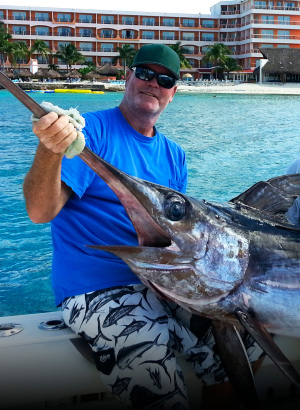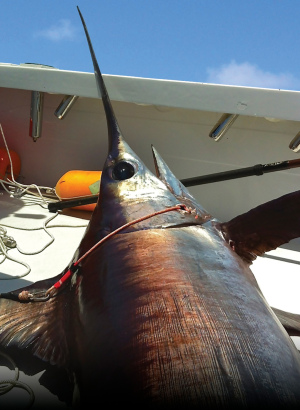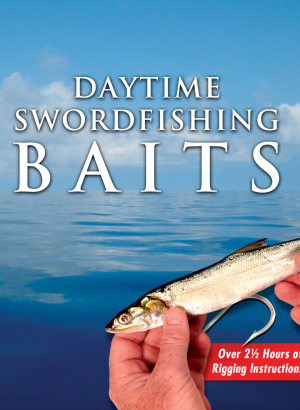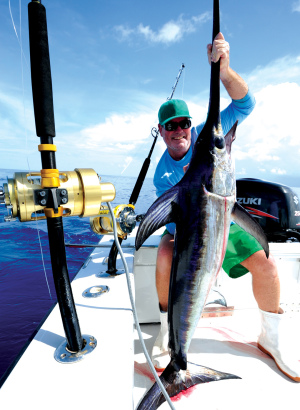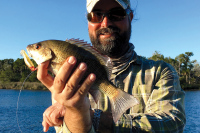This guide explores the biology, habitats, fishing methods, and conservation efforts of the swordfish, a legendary and elusive species. It explains the unique sword-like bill, best times, equipment, baits, lures, and techniques used. It also highlights the importance of dedication and sustainable practices in preserving swordfish populations for future generations.
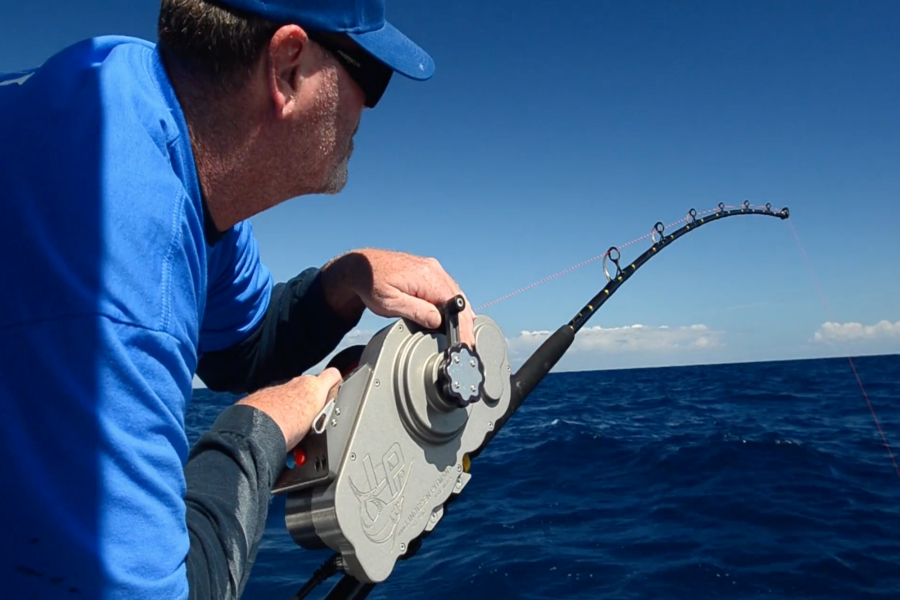
How to Catch Swordfish – Start with Knowledge
The swordfish, a magnificent creature of the deep, has long been a subject of fascination among anglers and ocean enthusiasts alike. With its elongated, sword-like bill and impressive size, the swordfish (Xiphias gladius) is a true marvel of the marine world. Renowned for its incredible strength and speed, the swordfish has earned a reputation as one of the most challenging and rewarding game fish to pursue.
Summary
- Biology of Swordfish: Swordfish, known scientifically as Xiphias gladius, can grow over 9 feet and weigh up to 1,500 pounds. Their unique sword-like bill aids in hunting.
- Habitat: They inhabit the Atlantic, Pacific, and Indian Oceans, seeking areas where warm and cold water masses converge.
- Best Times: Seasonal migrations and daily feeding patterns dictate the best fishing times. Monitoring factors like temperature and moon phase can also be advantageous.
- Equipment: Specialized heavy tackle, including robust rods, reels, and other gear, is essential for success.
- Bait and Lures: Oily fish and squid are top choices. Natural movement and scent trails are crucial.
- Fishing Techniques: Methods like drift fishing, high-speed trolling, deep dropping, and kite fishing are employed based on conditions.
- Conservation: Sustainable practices and regulations have helped protect swordfish populations from overfishing.
- Dedication: Successful swordfishing demands dedication, practice, and respect for the sport.
The Art and Science of Catching the Magnificent Swordfish
The swordfish, an awe-inspiring apex predator, has long been a subject of fascination for anglers worldwide. With its impressive size, reaching lengths of up to 14 feet and weighing over 1,000 pounds, the swordfish commands respect and admiration from those who pursue it. Its streamlined body, powerful tail, and elongated bill make it a formidable fighter, capable of incredible bursts of speed and acrobatic leaps.
Catching a swordfish is no easy feat, requiring a combination of skill, technique, and knowledge. Anglers must understand the biology and behavior of these magnificent creatures to increase their chances of success. Swordfish are known to inhabit a wide range of depths, from the surface to over 1,800 feet, and are often found near underwater structures such as seamounts, canyons, and drop-offs.
To target swordfish effectively, anglers employ various methods, including daytime deep drop fishing and nighttime drift fishing. Each technique requires specialized gear, such as heavy tackle, electric reels, and specific bait presentations. Expert anglers have honed their skills over years of experience, learning to read the ocean conditions, currents, and weather patterns to locate and entice these elusive predators.
Conservation efforts play a crucial role in preserving swordfish populations for future generations. As with many marine species, swordfish have faced challenges due to commercial overfishing and habitat degradation. International organizations and governments have implemented management measures, such as catch limits, size restrictions, and seasonal closures, to promote sustainable fishing practices. Additionally, the use of circle hooks and the practice of catch-and-release have been encouraged to minimize post-release mortality.
Anglers have a responsibility to engage in responsible fishing practices and support conservation initiatives. By adhering to regulations, using appropriate gear, and practicing ethical catch-and-release techniques, anglers can contribute to the long-term sustainability of swordfish populations. Furthermore, participating in research projects, such as tagging programs, can provide valuable data to scientists studying swordfish biology and migration patterns.
In this comprehensive guide, we will delve into the fascinating world of swordfish, exploring their biology, habitat preferences, and feeding habits. We will also provide expert insights into the most effective methods and gear for catching these magnificent creatures, sharing tips and techniques from seasoned anglers. Additionally, we will highlight the importance of conservation efforts and discuss how anglers can play a vital role in preserving swordfish populations for generations to come.
Whether you are a seasoned angler seeking to refine your skills or a newcomer eager to embark on the ultimate angling adventure, this guide will equip you with the knowledge and inspiration to pursue the legendary swordfish. Get ready to embark on a journey filled with excitement, challenges, and the opportunity to witness the raw power and beauty of one of the ocean's most captivating predators.
Bonus Video: Swordfishing - Daytime Broadbill Seminar with RJ Boyle
Expert on midday swordfishing in Florida RJ Boyle presents a session on technical matters related to dropping broadbill swordfish. In addition to tackle and rigging, he covers boat steering, drift setting, currents, bait targeting, and identifying bites from fish in the vicinity. RJ provides expert advice on all facets of daylight swordfish fishing. Learn More Here
An Introduction to the Mighty Swordfish
The swordfish (Xiphias gladius) is a marine pelagic fish renowned as an exceptional game fish. Reaching lengths over 9 feet and weights approaching 1,500 pounds, the swordfish is the definition of a monster fish. They are native to tropical, subtropical and temperate waters worldwide. Their characteristic elongated, flattened bill gives them their name, as it resembles a sword. This unique adaptation allows them to slash through shoals of fish and incapacitate prey.
Swordfish are sleek, streamlined swimmers capable of bursts of speed over 60 mph. They spend the majority of their time in epipelagic and mesopelagic zones of the ocean, hunting for prey during vertical migrations. Swordfish undergo extensive migrations, travelling thousands of miles between feeding and spawning grounds. They follow temperature boundaries and can cover vast distances searching for food.
Where to Find Swordfish
Swordfish inhabit a widespread range, found in the Atlantic, Pacific and Indian Oceans. In the Western Atlantic, some of the most popular fishing grounds include the Gulf Stream off Florida, Georges Bank off New England, and the Grand Banks off Newfoundland. Other notable fisheries exist off California, Australia, the Mediterranean Sea, Brazil and beyond.
When targeting swordfish, anglers look for temperature breaks along current edges where warm and cold-water masses converge. Rip lines and areas of upwelling are also promising areas to find concentrations of bait fish that attract swordfish. Islands, underwater plateaus, reefs and canyons can provide structure that aggregates both prey and predator. Understanding oceanographic features is key to locating swordfish grounds.
Best Times to Catch Swordfish
The seasonal migration patterns of swordfish offer guidance on the optimal times to target them. In lower latitudes, swordfish catches peak during the winter and spring. In Florida, the fishing heats up November through April when the fish migrate south into warmer waters. The summer months offer great opportunity along the Northeast coast before the fall migration commences.
Daily feeding patterns also inform when to fish for swordfish. They typically feed at sunrise, sunset and throughout the night when prey species rise to surface waters. Daytime fishing can also be productive by targeting deep haunts. Experienced anglers carefully watch barometric pressure, wind, temperature, currents and moon phase to pinpoint when swordfish will be most active and aggressive towards baits.
Swordfish Tackle and Gear
Catching swordfish demands specialized heavy tackle designed for big game fishing. The muscular fish and extreme depths require robust gear to battle them successfully. Critical components include:
- Rods - 6 to 9 foot roller-tip or boat rods rated for 80 to 130 pound test line. Fiberglass and graphite composite blanks offer a perfect blend of strength, sensitivity and forgiveness needed to fight swordfish.
- Reels - Lever drag or star drag reels holding 1500+ yards of 80 to 130 pound braided line. Electric reels provide mechanical advantage when hand cranking from great depths.
- Terminal Tackle - Large bait hooks from 10/0 to 12/0, connected to 400+ pound test wind-on leaders and 300+ lb test crimp sleeves. Swordfish have keen eyesight and will shy away from bulky tackle.
- Gaffs - Strong gaffs with long shanks are needed to hoist large swordfish out of the water. A hay hook is also a great tool, afixed on the eye socket, for hauling swords into your boat.
Having a seasoned crew and properly outfitted boat capable of handling heavy gear is also critical for success.
Seth Horne, Creator at In The SpreadBest Baits and Lures for Swordfish
When it comes to selecting the right bait for swordfish, durability and presentation are key. Swordfish are known for their powerful bills, which they use to slash and stun their prey. To withstand this force, anglers must choose baits that are tough and resilient. Hardy fish species like bonito, mackerel, mullet, dolphin belly, and ballyhoo are excellent choices, as they produce a strong scent trail that attracts swordfish from a distance. Squid is another popular option, as it is a natural prey item for swordfish and has a tough, rubbery texture that can withstand their attacks.
Proper rigging is essential to ensure that the bait remains intact and swims naturally in the water. Anglers must take care to prevent the bait from spinning or tearing apart, which can deter swordfish from striking. Techniques such as using a double hook rig or a single hook with a pin can help keep the bait in place and maintain its lifelike appearance.
In addition to natural baits, lures offer a convenient and consistent alternative. Large rubber squids and other soft plastic eels are popular choices among swordfish anglers. These lures can be rigged to mimic the movement of real prey and can be fished at various depths to target swordfish. The predictable action of lures eliminates the need for constant bait checks and reduces the risk of bait damage.
Regardless of the chosen bait or lure, it is crucial to keep it fished near the bottom where swordfish typically feed. Swordfish are known to inhabit deep waters, often near underwater canyons, seamounts, and drop-offs. By positioning the bait in these areas and maintaining a natural presentation, anglers can greatly increase their chances of enticing a strike from a trophy swordfish.
Successful swordfish fishing requires a combination of the right bait selection, proper rigging techniques, and the use of advanced electronics to locate and monitor the fish. By understanding the feeding habits and preferences of swordfish, anglers can adapt their strategies to maximize their chances of landing one of these magnificent deep-sea predators.
Swordfish Fishing Techniques
Swordfish are known for their elusive nature and incredible fighting abilities, making them a highly sought-after target for anglers worldwide. To successfully fool these magnificent predators, anglers employ a variety of techniques, each with its own unique advantages and challenges. Let's explore some of the most effective methods used to catch swordfish.
Nighttime Drift Fishing
Nighttime fishing for swordfish is a thrilling and highly effective approach that takes advantage of the species' nocturnal feeding habits. As the sun sets and darkness envelops the ocean, swordfish become more active and tend to venture closer to the surface in pursuit of prey. This behavior presents a unique opportunity for anglers to target these magnificent predators using a variety of techniques and specialized equipment.
One of the most classic and proven methods for nighttime swordfish fishing is allowing baited lines to drift over structures where swordfish are known to hunt. Underwater canyons, seamounts, drop-offs, and other prominent bottom features are prime locations to focus on. These areas often attract baitfish and squid, which in turn draw in hungry swordfish.
To maximize their chances of success, anglers typically deploy multiple lines at different depths, creating a spread that covers various water columns. This approach allows them to explore different zones and identify the specific depths where swordfish are holding. By staggering the lines and using a combination of natural baits such as squid, mackerel, or bonito, anglers can entice swordfish with a diverse array of offerings.
Modern electronics have revolutionized nighttime swordfish fishing by providing anglers with valuable information about the underwater environment. High-quality fish finders and sonar systems enable anglers to identify specific contours, drop-offs, and bottom features that are likely to hold swordfish. By marking these locations and using GPS technology, anglers can precisely drift their baits over the most promising areas, increasing their chances of encountering a trophy swordfish.
In addition to traditional baits, the use of illuminated attractants has become increasingly popular in nighttime swordfish fishing. Illuminated floats, chemical lightsticks, and luminescent lures all play a crucial role in grabbing the attention of swordfish in the dark depths. These glowing devices mimic the bioluminescence of certain prey species and can trigger explosive strikes from curious swordfish.
When using illuminated attractants, anglers often attach them above or near the bait, creating a visual target for swordfish to hone in on. The mesmerizing glow of these devices can be irresistible to swordfish, enticing them to investigate and ultimately strike the bait. The sudden burst of light and the commotion caused by a swordfish attack adds an extra level of excitement to the nighttime fishing experience.
To further optimize their success, experienced swordfish anglers pay close attention to factors such as moon phases, tides, and weather patterns. Swordfish activity can be influenced by these variables, and understanding how they impact feeding behavior can help anglers select the most productive times to be on the water.
Nighttime swordfish fishing requires specialized equipment, including heavy-duty rods, reels with high line capacity, and strong leaders to withstand the powerful runs and head shakes of these formidable fighters. Anglers must also prioritize safety, ensuring proper lighting on the boat, using glow-in-the-dark or reflective materials on their gear, and following all necessary precautions when fishing in low-light conditions.
The thrill of battling a massive swordfish under the starlit sky is an experience that many anglers dream of. The combination of strategic drifting, utilizing modern electronics, and employing illuminated attractants has made nighttime swordfish fishing more accessible and successful than ever before. With patience, skill, and a bit of luck, anglers can unlock the secrets of the night and come face-to-face with one of the ocean's most magnificent predators.
Deep Dropping
Daytime deep dropping has revolutionized the way anglers target swordfish, allowing them to access the depths where these magnificent predators reside during the sunlit hours. This specialized technique involves using state-of-the-art electric reels and heavy-duty gear to deliver baits to the deep, dark realm of the swordfish, often exceeding depths of 1,500 feet.
At such incredible depths, swordfish find sanctuary from the bright sunlight and feast on the abundant deep-sea prey. These depths are home to some of the largest and most impressive specimens, making daytime deep dropping an enticing prospect for anglers seeking trophy-sized swordfish.
To effectively target swordfish at these extreme depths, anglers rely on specialized electric reels that are designed to quickly drop and retrieve baits and do battle with giant swordfish. These reels are equipped with powerful motors that can quickly and efficiently retrieve the line and drive hooks. The use of braided line with high breaking strength is essential to withstand the strain and abrasion caused by the deep-water environment.
Precision is paramount when it comes to bait placement in daytime deep dropping. Swordfish are known to be highly selective feeders, and presenting the bait at the exact depth and location where they are holding can make all the difference. Anglers use a combination of high-quality sonar and fish finders to identify the specific underwater structures, such as canyons, ledges, or seamounts, where swordfish are likely to congregate.
To reach these precise depths, anglers employ the use of heavy weights, often ranging from 2 to 15 pounds or more, depending on current. These weights are attached to the line above the bait and help to quickly descend the offering to the desired depth. The weight of the rig is carefully calculated based on factors such as the strength of the current, the depth of the target zone, and the size of the bait being used.
Once the bait reaches the intended depth, it is crucial to maintain a steady and controlled drift over the targeted structure. This requires a delicate balance between the boat's movement and the amount of line deployed. Anglers must constantly monitor their sonar and make adjustments to their drift to ensure that the bait remains in the strike zone for as long as possible.
The choice of bait is critical in daytime deep dropping for swordfish. Large, whole squid or fish such as bonito or mackerel are popular options. Belly baits cut from bonito or dolphin are also super productive.These baits are rigged with heavy-duty hooks and leader material to withstand the crushing jaws and powerful head shakes of a hooked swordfish.
When a swordfish takes the bait, the electric reel comes into play, allowing the angler to quickly retrieve the line and set the hook. The battle that ensues is a true test of strength and endurance, as swordfish are known for their incredible power and stamina. Anglers must be prepared for long, grueling fights that can last several hours, as the swordfish uses its immense size and the depth of the water to its advantage.
Landing a deep-dropped swordfish is a true achievement and a testament to the angler's skill, patience, and determination. The sight of a massive swordfish emerging from the depths is a moment of pure exhilaration and a reward for the hours of preparation and perseverance.
Daytime deep dropping has opened up new frontiers in swordfish fishing, allowing anglers to target these elusive predators in their deepwater haunts. With the right equipment, techniques, and a healthy dose of respect for the power of these incredible creatures, anglers can experience the ultimate challenge and thrill of pursuing swordfish in the depths of the ocean.
Sight Fishing
Sight casting live baits to surface swordfish is an exhilarating and highly visual technique that has gained popularity among anglers, particularly in the waters off Southern California. This method takes advantage of the unique behavior exhibited by swordfish in this region, where they are known to bask at the surface, presenting a rare opportunity for anglers to target them in plain sight.
When swordfish rise to the surface, they often remain stationary or swim slowly, basking in the sunlight. This behavior is thought to serve various purposes, such as regulating body temperature, conserving energy, or even as a form of camouflage to ambush unsuspecting prey. Regardless of the reason, this surface activity provides anglers with an exciting chance to sight cast live baits directly to these magnificent predators.
To successfully sight cast to surface swordfish, anglers must first locate them. This requires keen observation skills and patience. Anglers scan the water's surface for signs of swordfish, such as their distinctive dorsal fin or tail breaking the surface, or the telltale shimmer of their silver flanks. Polarized sunglasses and a high vantage point, such as a tower or flybridge, can greatly enhance the ability to spot swordfish from a distance.
Once a swordfish is located, the angler must carefully approach within casting range without spooking the fish. This requires a stealthy and precise boat handling, as well as a quiet deck to avoid any unnecessary noise that could alert the swordfish to the boat's presence.
The choice of live bait is crucial when sight casting to surface swordfish. Mackerel, bonito, and small tuna are popular options due to their durability and attractiveness to swordfish. These baits are typically rigged with a single, large hook and a strong leader material to withstand the powerful jaws and head shakes of a hooked swordfish.
When the boat is in position and the swordfish is within range, the angler must make an accurate cast, placing the live bait as close to the swordfish as possible without hitting it directly. This requires skill and finesse, as the bait must land gently and swim naturally to entice the swordfish to strike.
If the swordfish shows interest in the bait, the angler must allow it to swim freely and avoid any sudden movements that could spook the fish. The swordfish may circle the bait, follow it closely, or even nudge it with its bill before committing to the strike. This visual interplay between predator and prey is what makes sight casting to surface swordfish such a thrilling and immersive experience.
When the swordfish finally takes the bait, the angler must be prepared for an explosive strike and an immediate, powerful run. Setting the hook quickly and firmly is essential to ensure a solid connection with the fish. From that moment on, the battle begins, as the swordfish uses its immense strength and speed to try to shake off the hook and escape.
Sight casting to surface swordfish requires specialized gear, including heavy-duty rods, reels with smooth drags, and high-quality line. Anglers must also be prepared for long, demanding fights that can test their physical endurance and mental resolve.
Landing a swordfish caught through sight casting is a true testament to the angler's skill, patience, and quick reflexes. The satisfaction of fooling a swordfish in plain sight and engaging in a close-quarters battle is an experience that many anglers dream of.
While sight casting to surface swordfish is most commonly associated with Southern California, this technique can be applied in other regions where swordfish are known to exhibit similar basking behavior. As more anglers discover the thrill and challenge of this method, it continues to gain popularity and push the boundaries of what is possible in swordfish fishing.
Fighting and Landing Swordfish
Hooking a swordfish is just the beginning of an epic battle that tests an angler's skill, endurance, and resolve. These gladiators of the deep are renowned for their raw power and relentless fighting spirit. When a swordfish takes the bait, it unleashes blistering runs that can strip hundreds of yards of line off the reel in mere seconds. Experienced anglers know to back off on the drag during these initial runs, maintaining steady pressure to prevent the hooks from pulling free.
As the fight progresses, the angler must employ a combination of drag manipulation and reeling techniques to regain line and gradually wear down the swordfish. This requires a delicate balance of applying pressure and yielding to the fish's powerful surges. The angler and the boat wheelman must work in perfect unison, anticipating each other's movements and adapting to the swordfish's ever-changing tactics.
Battling a swordfish that can weigh over 500 pounds leaves no room for error. Every aspect of the angler's technique must be flawless. A single mistake, such as allowing slack in the line or applying too much pressure at the wrong moment, can result in a pulled hook or a parted leader. Hours of effort can be lost in an instant, leaving the angler with nothing but a tale of the one that got away.
The fight with a swordfish is a true test of wills, a battle of attrition between man and beast. It requires unwavering focus, physical stamina, and mental fortitude. The angler must be prepared to endure aching muscles, blistered hands, and the relentless heat of the sun. But the reward for perseverance is the opportunity to land one of the ocean's most magnificent and respected game fish.
Even as the swordfish tires and the end of the battle draws near, the angler cannot let their guard down. The final moments of the fight are often the most critical, as the swordfish may make one last desperate surge or attempt to dive beneath the boat. Only when the fish is safely subdued and brought alongside the vessel can the angler finally breathe a sigh of relief.
Boating a swordfish is a moment of triumph and reverence. As the angler gazes upon the majestic creature they have bested, they are filled with a mix of awe, respect, and gratitude. The experience of battling a swordfish is one that will be etched in their memory forever, a testament to their skill and dedication as an angler.
Hooking and landing a swordfish is a true test of an angler's mettle. It demands the utmost respect for the fish, the ocean, and oneself. Those who have experienced the thrill of this incredible challenge know that it is not just about the catch itself, but about the journey and the lessons learned along the way. It is a reminder of the raw power and beauty of the natural world, and of the indomitable spirit that lies within those who dare to pursue their dreams on the open water.
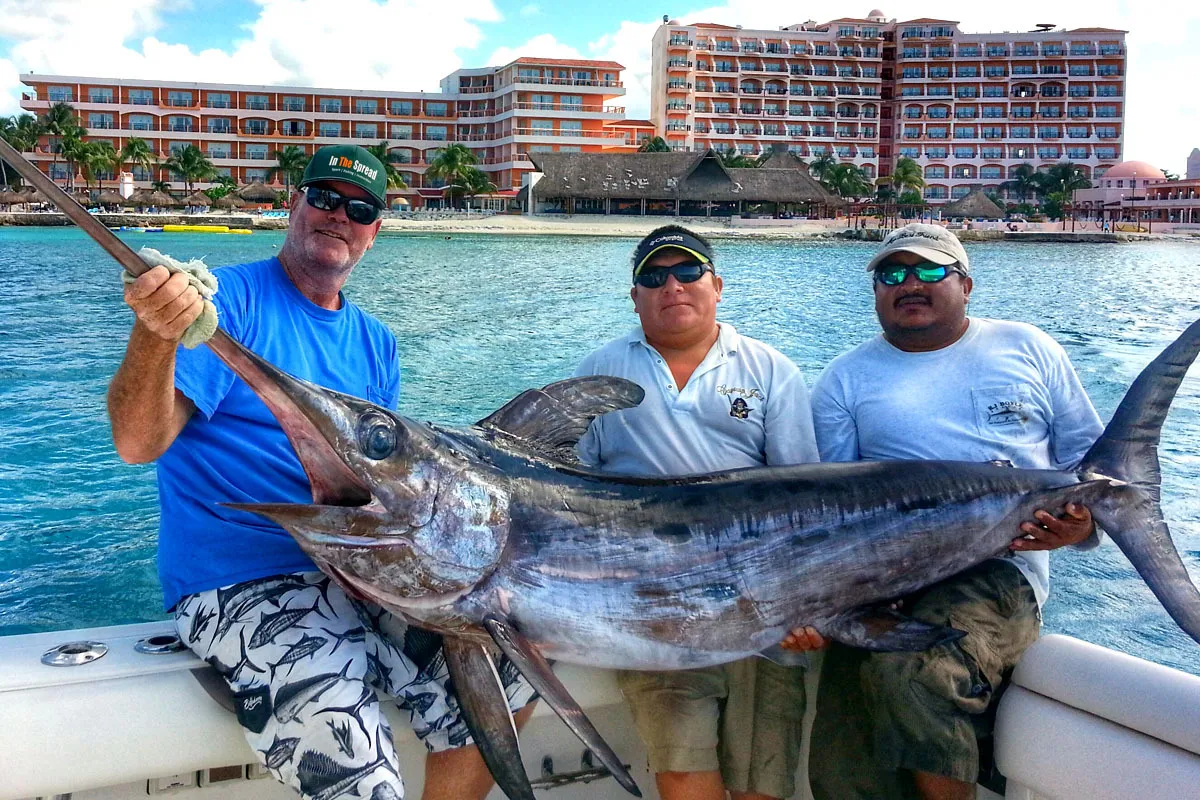
Swordfish Conservation
Swordfish have been fished commercially since ancient times. Consumer demand for swordfish peaked in the 1990's, putting pressure on populations. However, forward-thinking management has helped curtail overfishing.
Strict quotas, minimum size limits, monitoring and fishing bans in certain areas have all aided conservation efforts. The West Atlantic swordfish stock has fully rebounded and is now considered sustainable. Eco-conscious anglers can enjoy the challenge of swordfishing while also promoting responsible practices.
By following regulations, using circle hooks, and carefully releasing unwanted catches, recreational anglers help protect swordfish stocks for the future. Planning trips when swordfish congregate also minimizes unnecessary deaths from sharks and marine mammals. Through stewardship and education, swordfish will continue thrilling anglers for generations.
Swordfishing Success Takes Dedication and Practice
Many dream of catching a broadbill swordfish, but only those willing to put in the work achieve success. It requires commitment to gain the knowledge, skills and equipment needed for these epic battles. Veterans spend decades mastering the many intricacies.
For reward, swordfishing offers the chance to test yourself against one of the ocean's greatest big game fish. The memories made during the long nights, close calls, victories and defeats last a lifetime. While not easy, those who put in the time on the water will be handsomely rewarded. When everything comes together, all the preparation culminates in the moment when the leader touches the rod tip and a swordfish appears by the boat. That is a feeling like no other.
Conclusion
The swordfish is an iconic creature revered by anglers. Though elusive and challenging to catch, those willing to take up the challenge will find it immensely rewarding. Successful swordfishing relies on understanding their biology and behavior, fishing during peak conditions, having properly outfitted boats and tackle, and mastering specialized techniques. With responsible practices, swordfish populations will provide thrilling fishing opportunities for generations to come. For adventurous anglers, few experiences compare to facing off against a broadbill swordfish and winning the battle.
Seth Horne In The Spread, Chief CreatorUser Reviews



